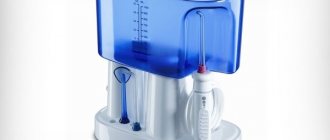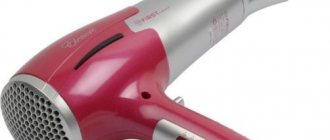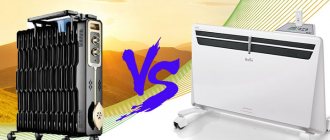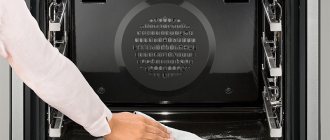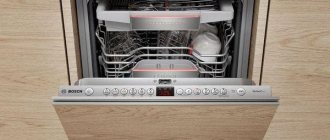What types of toothbrushes are there?
In general, all instruments for caring for teeth and the oral cavity according to the principle of action and functions are divided, in fact, into just 2 groups - these are mechanical, that is, the most common ones, as well as electric ones, which contain a battery that leads to the movement of the head or only her bristles. Electric ones, in turn, are divided into classical (the head simply moves), sound and ultrasonic (waves are added here), as well as ionic (negatively charged ions are additionally “included” in the work, which lead to effective destruction of plaque). They all differ from each other in the degree of stiffness of the bristles, the material of the bristles, and the size and shape of the cleaning head.
Any models can also be equipped with various and original additions:
- rubber insert on the handle,
- indicator bristles,
- use of silver ions,
- multi-directional or multi-level bristles,
- textured tongue cleaning pad,
- ribbed surface for gum massage.
Each type of teeth cleaning tool has its own advantages and disadvantages. Before making a choice, you should know what a sound electric device means, what is the principle of its operation, what are the differences from other types of dental care instruments, and are there any contraindications for use.
Operating principle of ultrasonic
Cleansing models that use sound work completely differently. In addition to bristles, their head has a generator of high-frequency sound and ultrasonic waves .
The impact of waves directed at the enamel destroys plaque and creates a flow of fluid in the mouth, carrying away dirt and germs.
Keep in mind! All this is combined with mechanical cleaning, during which the fibers make up to 30 thousand vibrations per minute.
Advanced sonic brushes produce ultrasonic vibrations with a frequency of 1.6-1.7 MHz.
This increases the vibration frequency of the bristles to 100 million vibrations.
Which, in turn, makes the whole process significantly more efficient. electrical appliances clean teeth using rules that we often neglect.
Their cleaning heads move in the right direction and with the required pressure.
However, before brushing your teeth for the first time with an electric brush, you should study the instructions with it so as not to make mistakes .
When using an electric brush, there is no need to try to help it by making unnecessary movements.
You should know! Its point is to do all the work for the person, who can only direct the head to different areas of the teeth and gums.
The cleaning order is usual: first of all, the front walls and crowns of the teeth, then the back walls of both jaws. You need to hold the brush almost freely and not put pressure on your teeth.
The built-in timer, if there is one, measures exactly 2 minutes for cleaning.
After their expiration, the product automatically turns off and also sounds a sound signal to change the cleaning zone every half a minute.
Device and principle of operation
Such models date back to 1992. The device is a structure consisting of a handle with a built-in electric motor, a battery (or batteries) and a bristle head. The brush is called “sonic” because a microgenerator produces high-frequency waves, the vibrations of which cause the bristles to rotate and help clean plaque from teeth. Modern dental appliances of this type operate with a frequency of 500-1500 Hz and, depending on the model, are capable of 30-90 thousand vibrations per minute. Such a speed of movement, of course, is beyond the strength of a human hand.
For comparison! The number of rotations or vibrations that an innovative electric brush creates, we can do on our own with a regular hygiene product in at least 2-3 months. When brushing your teeth with a regular classic brush, you can achieve, with a lot of effort, only 250 vibrations per minute.
The bristles on the brush move in a circle, but some models use a combination of pulsating and reciprocating movements. The high amplitude of vibration creates an emulsion of saliva, water and toothpaste, which is able to penetrate into the spaces between teeth and hard-to-reach places. Thanks to this, not only a thorough cleaning of the enamel and interdental spaces occurs, but also the splitting of plaque. Many models are equipped with a timer that regulates the time spent cleaning the mouth.
Features of sonic teeth cleaning
The operating principle of the device is based on high frequency vibration. There is a plate in the nozzle head. It creates vibrations of sound waves. The impulse is transmitted through the nozzle head to the bristles, which rotate at enormous speed - up to 40 thousand revolutions per minute. This creates a dynamic flow, which consists of saliva, paste, water and air bubbles. This mixture, under the influence of sound waves, penetrates into hard-to-reach places in the oral cavity.
You can use prophylactic toothpaste for cleaning.
Manufacturers have products with different abrasiveness index (ability to grind a surface). The higher it is, the greater the likelihood of damaging the enamel. For this reason, such pastes are used no more than 1-2 times a week. When brushing with a sonic brush, some people use tooth powder and combine it with a medicinal balm to rinse the mouth.
Advantages of the models
Compared to mechanical models, sound ones have both pros and cons. Due to active movements, dynamic fluid flow and wave vibrations, the main advantages of modern models include the following:
- high efficiency in cleaning tooth enamel compared to any other models,
- effective removal of deposits even from under the gums, from very narrow gaps between teeth, that is, very deep cleansing of the entire oral cavity,
- ease of use,
- light massage effect on the gums,
- can be used for teeth with sensitive enamel,
- economical consumption of toothpaste,
- ergonomic design,
- allowed for use in children,
- reliability of the device and a fairly long service life.
This type of device is ideal for coffee and tobacco lovers. These products darken the enamel, while sound vibrations help lighten the tooth enamel by one or two tones. It is impossible to achieve such whitening with other, especially classic models.
In what cases is each recommended?
In order to decide on the choice of the tool that suits you, you need to consider the advantages and disadvantages of each of their types.
Next, we’ll take a closer look at the pros and cons of sonic and electrical cleaning devices.
We will also describe situations when it is worth choosing one or another tool.
Sound devices
You should know! Sonic and ultrasonic brushes have the following advantages:
- They cope with dental plaque and stains much more . Destroy harmful microorganisms and bacteria even in hard-to-reach places.
- High frequency of movement of the villi, and, accordingly, the speed of the cleaning procedure .
- Does not injure healthy gums.
- Suitable for sensitive teeth.
- Many additional and useful features.
However, there are a number of contraindications and disadvantages when using ultrasonic brushes. They are associated with vibrations and vibrations at high frequencies :
- Cannot be used by pregnant women.
- Not recommended for use if you have a pacemaker.
- Reducing the service life of artificial products (crowns, fillings, braces, etc.).
- Inflammatory gum diseases.
- High price.
Electric models
Reference! Advantages of standard vibrating rotary electric brushes:
- easy to use;
- modest price;
- higher efficiency compared to conventional cleaning devices .
Disadvantages and contraindications include:
- risk of damaging the mucous membrane and enamel if used incorrectly;
- low cleaning efficiency compared to sonic and ultrasonic analogues;
- periodontal disease, gingivitis and stomatitis;
- recent surgery;
- neoplasms;
- wedge-shaped defects of the tooth neck;
- bruxism.
Know! Having analyzed all of the above, we can roughly say in which cases this or that type of oral hygiene instrument is suitable.
So, a sonic brush is ideal if there are no contraindications, but there are such features as :
- Plaque.
- Pigmented teeth.
- Exposure to adverse factors (coffee, smoking, etc.) that affect increased plaque formation and oral microflora.
- Reluctance to spend a lot of time cleaning.
- Willingness to pay a higher price for greater efficiency.
A standard electric toothbrush is right for you if:
- you are not ready to spend a lot of money;
- you have healthy teeth, non-sensitive enamel and gums;
- it is necessary to avoid carious formations;
- you need to reduce cleaning time and increase its efficiency compared to a regular brush.
Contraindications to the use of devices
The disadvantages include the high price, which, however, is compensated by long-term operation. Also, these models are not recommended for use by people with dental health problems.
Despite their safety and many advantages, brush models have a number of contraindications for daily use:
- pregnancy, especially in the first trimester,
- diseases of the oral cavity (hypertrophic gingivitis, periodontitis),
- high tooth mobility,
- surgical interventions in the oral cavity,
- acute and chronic inflammatory processes of tooth roots,
- demineralization of enamel,
- severe tooth wear,
- presence of a pacemaker,
- neoplasms of various types in the mouth,
- bruxism,
- defects of the dental neck.
It is not recommended to use products with a large number of fillings, implants, crowns, veneers, bridges and dentures. A high-frequency sound wave has a negative effect on artificial products, causing not only them, but also premature destruction of fixation compounds.
Advantages and disadvantages of ultrasonic
Ultrasonic cleaning devices are more gentle and do not lead to enamel abrasion .
At the same time, they have all the advantages of electric brushes .
Ultrasound prevents the formation of tartar and prolongs fresh breath.
However, they have a number of contraindications :
- the presence of dental crowns and fillings (ultrasonic vibrations can lead to wear and tear of structures and reduce their service life);
- pregnancy (ultrasound waves can negatively affect the health of the fetus);
- the presence of tumors in the oral cavity ;
- the presence of a pacemaker.
Important! The destruction and loss of the filling can lead to the appearance of caries in the adjacent areas and the appearance of foci of inflammation in the tooth.
Comparison of a sonic brush with a conventional mechanical one
The regular toothbrush has changed very little over its more than 2,000-year existence and also has its advantages. These include compactness and simplicity, acceptable (and one might even say very low) price, absence of contraindications, the possibility of frequent replacement, since even the cheapest option will be available to low-income people, low trauma to teeth and gums when used correctly, cost-effectiveness .
But despite all the advantages, a mechanical brush is significantly inferior to a sonic brush in the quality of cleaning teeth and gums. The advantages of sonic toothbrushes include high cleaning power with a minimum of movements. In fact, a person does not need to do anything - just move the brush along the teeth, and it will do everything on its own. Under the influence of waves, plaque splits even in hard-to-reach places. If the operating rules are followed, the device can be used for a long time without losing its functions.
Advantages of electric brushes
To properly clean your teeth, you need to make about three hundred movements per minute. This cannot be done using a conventional tool. Such devices have a positive effect on the condition of teeth and also solve the problem of tartar in the long term.
High-quality devices – cleanliness and beauty of the oral cavity
Other advantages of their use include:
- Protection against caries. The main advantage of using electric models is the thorough removal of plaque, which is the main cause of caries.
- Easy to clean teeth. Not every person follows the rules of cleaning the oral cavity, which leads to the fact that dangerous plaque, stone, and pathogenic microorganisms remain in it. For high-quality cleaning using such a tool, less effort is required.
- Safety. If you use such models correctly, it is impossible to damage your gums. Therefore, these brushes are recommended for children who do not take good care of their oral hygiene.
Using an electric model can be a great solution for people with arthritis or other conditions that make brushing their teeth difficult.
Sonic or electric toothbrush – which is better?
Both sonic and electric with a rotating head are both electric. They operate from a charged battery or batteries. The fundamental difference between a sonic brush is the frequency of movement of the bristles and the participation in cleaning waves (bristles + speed + waves). We can say that a sonic electric brush is a more advanced model of an electric one.
When electric brushes appeared, many began to abandon the classic models in favor of them - the rotational movements that an electric toothbrush makes provide good quality in cleaning teeth from plaque. But over time, it became clear that despite all its innovation, this method of daily care is still not 100% effective in a number of situations - food particles still settle between the teeth and become clogged under the gums. This forced scientists and developers to improve the electric brush model - this is how first the ultrasonic and then the sonic brush appeared (see the difference between the latter two below).
What makes a sonic toothbrush different is the presence of sound waves. The combination of high-speed rotational movements and sound vibrations contributes to the greatest effectiveness of hygiene measures. The softened plaque peels off the tooth and is washed away even from the most previously inaccessible places. For the oral cavity, devices of this type are less traumatic, and therefore preferable.
Important! Unlike a standard electric toothbrush, a sonic toothbrush has a larger list of contraindications - it cannot be used if you have dentures, braces, implants, or if you have electrical devices, such as pacemakers.
Which toothbrush is better to choose - electric or ultrasonic?
Of all the varieties, ultrasonic brushes are considered the most effective in terms of whitening and disinfection. There are several main advantages of such models.
- Most ultrasonic devices combine 2 methods of exposure - high-frequency radiation and intense vibration up to 100,000 revolutions. Thanks to this, the maximum quality of dental treatment is achieved. Even if the device’s fibers do not reach hard-to-reach places, ultrasound penetrates into all recesses and crevices and destroys deposits.
- The devices have a beneficial effect on blood circulation in the oral cavity. If you use them on a regular basis, the gums will quickly become stronger, the manifestations of periodontal disease will decrease, and the “pockets” in the soft tissues in the cervical area will become smaller. The impact of ultrasound can be compared to a high-quality massage, only the effectiveness of high-frequency vibrations is higher, despite the lack of physical impact.
- Brushes of this type help fight infectious and bacterial processes. Ultrasound radiation suppresses the activity of microorganisms and acts as a high-quality antiseptic. When using the device, you don’t have to worry that after each meal, microbes will multiply in the gaps between your teeth and gum pockets. Ultrasonic devices slow down the development of caries and prevent periodontal disease and pulpitis.
- Brushes that support high-frequency ultrasound radiation quickly return teeth to a uniform white shade, even with frequent consumption of coffee and tea or smoking. The enamel is not destroyed during the process, but after dental whitening, the teeth often become very sensitive.
Ultrasonic electric brushes help disinfect teeth and gums
At first glance, it seems that the advantages of ultrasonic brushes are completely obvious. But they also have some disadvantages.
- High price. In the ranking of sonic electric toothbrushes, high-frequency models will be the most expensive.
- Negative impact on any artificial elements in the oral cavity. Ultrasound has a bad effect on dentures, crowns and even regular fillings and shortens their service life.
Thus, ultrasonic brushes will be optimal for a healthy dentition; they will protect the enamel from destruction and prevent the development of bacterial processes. But if you have implants, braces and numerous fillings, it is better to consult a doctor about the advisability of using the device. Most likely, the dentist will advise you to opt for a mechanical electric brush; it will be the safest.
Difference between sonic and ultrasonic models
Both devices work virtually similar to each other, but an ultrasonic electric toothbrush produces ultrasonic waves that are longer in length. Compare, in sonic brushes there are about 30 thousand sound vibrations per minute, and in ultrasonic brushes this number starts from 100 million. Increasing the frequency and speed of rotation by several orders of magnitude has both its advantages and significant disadvantages.
Thanks to the increased power, toothbrushes with ultrasound acquire a number of advantages; the bristles rotating at ultrasonic speed carefully remove soft deposits and destroy harmful microorganisms; penetration of ultrasound to a depth of 4 mm helps remove plaque in places inaccessible to other types of devices; ultrasonic waves can have a therapeutic effect on the periodontal groove, shallow periodontal canals, interdental spaces, high-frequency ultrasound helps to release healing components from toothpaste, thereby helping to strengthen the enamel.
Ultrasonic models perform antibacterial and disinfecting functions and stimulate metabolic processes. Their action can be compared to a portable scaler, which periodontists use to treat gum disease and clean plaque. But along with the fact that such enhanced hygiene procedures are not carried out every day in a dental office, ultrasonic brushes, when used daily, can in some cases cause harm, especially in the presence of oral diseases. At a high oscillation frequency, the amplitude of movement of the bristles becomes extremely small, so the necessary sweeping movements are not carried out, as is done in sound analogues. Therefore, sound devices are still considered more effective.
Which brush is best for teeth?
Criteria for choosing a hygienic device:
- Type is a variety of models. If you want to keep up with the times, choose an ultrasonic device. If you are used to mechanical teeth cleaning, buy a manual device.
- The degree of hardness is determined based on the condition of the enamel, gums, and the age of the user. For adults with normal tooth sensitivity, medium or hard bristles are suitable, for children - soft, and for people with braces or dentures - extra-hard.
- Cost is determined by the manufacturer, availability for sale, functionality and completeness.
- Convenience – charging time, battery type, frequency of head changes, possibility of use by other family members.
- Technical parameters - number of revolutions, rotation speed adjustment.
- Additional functions - timer, tongue cleaning insert, head replacement indicator, silver ions, auto shut-off, teeth pressure sensor, etc.
- Dimensions of the working surface and length of the handle - the choice depends on the age of the user.
- Directionality is determined by the number and level of tufts in the bristles. There are hygienic, preventive and special types of brushes - for dentures or braces.
Sound or mechanical
These models differ in the principle of operation, so their comparison is not entirely correct. The choice of a sonic or manual toothbrush is based on personal preferences and product characteristics.
Advantages of a mechanical device:
- low price;
- availability;
- durability;
- no need to change batteries or attachments;
- you can buy several brushes with different hardnesses;
- Compact and easy to store.
- Carp in the oven: recipes with photos
- Teriyaki sauce: recipes with photos
- Exfoliating mask-socks for feet
Sound or electric
These products vary in price. The sound model is more expensive than the electric one. This is explained by a more modern operating principle - high frequencies for cleaning. Another difference between a sonic toothbrush and an electric one is the stationary working head. Only the bristles located on it rotate. The electric nozzle rotates, which often leads to injury to the oral cavity or plaque getting under the gums.
Sonic or ultrasonic
Models differ in vibration frequency. An ultrasonic brush is more powerful, creating about 100 million vibrations per minute, which significantly improves the quality of dental care. A high-frequency device cannot create a dynamic flow like an audio one. There are already combined models on the market that are equipped with generators to create medium and high frequency waves.
An ultrasonic brush ensures deep penetration of the paste and its absorption into tissues and tooth enamel.
Another advantage is its ability to destroy harmful bacteria. The sound model is cheaper. It is accessible to more people.
Best sonic toothbrush
Panasonic and Philips have high ratings in the dental products market. The first provides models with a standard set of functions for both home use and travel. Panasonic EW-DE92 is also available, equipped with an ionization function. Prices for electric brushes of the sonic type start from 7 thousand rubles. The second company (Philips) offers an impressive range of devices with a wide variety of functions, the cost of which ranges from 6-13 thousand rubles.
The manufacturer CS Medica produces reliable models with good performance indicators and several cleaning modes, while the price is an order of magnitude lower than that of the leaders. Sound devices from Omron, Xiaomi and Hapica have proven themselves well. All devices operate on the same principle, but differ in cost, power, functionality and design.
Operating principle
Simple electric toothbrushes appeared in the first half of the twentieth century, and only at the end of the century was the sound model invented. The peculiarity of this device is hidden in the name. A generator is built inside the mechanism, operating at high frequencies and producing sound vibration waves that are transmitted to the bristles. If an electric brush makes only mechanical movements, then a sonic brush makes mechanical, pulsating and sound movements, respectively. At the same time, the number of reciprocating movements of the bristles can reach up to 30 thousand per minute , which is beyond the power of any ordinary hand brush. Only professional cleaning can match the results of such indicators.
How to choose a sonic toothbrush
Stores today sell a wide range of teeth cleaning tools to suit every taste and budget. But before choosing a model, you should visit a dentist who will diagnose your oral cavity. After the examination, the specialist will be able to give recommendations on choice, taking into account the patient’s age, oral health, and the presence of contraindications. Before purchasing, you should also familiarize yourself with the technical characteristics, advantages and disadvantages of the selected model. Important points to note are the following:
- the number of vibrations of the fibers - the more there are, the higher the quality of cleaning,
- charging type: a device with batteries is not only more convenient, but also much more economical than analogues with batteries,
- hardness: it is best to pay attention to models with medium hardness, in this case the risk of damage to the enamel and mucous membrane is minimized,
- head shape: smooth and round with synthetic hairs is considered the most preferable,
- manufacturer: by giving preference to trusted companies, you can be sure of the high quality and reliability of the device.
When purchasing, you must remember that cost is not a priority indicator. You should choose based on your dentist’s recommendations and your preferences. It would be a good idea to read the reviews of those who already use such models. Most often, the price is inflated due to the presence of various functions that in reality turn out to be not very necessary. It is best to buy from retail outlets that specialize in selling such goods. In addition, it is in such stores that they give a long warranty on their products.
For your information! Sonic electric brushes can be used by children over three years old, but when purchasing, you need to focus on devices designed specifically for children of this age.
Ultrasonic toothbrushes
Ultrasonic toothbrushes are essentially mechanical too. However, they vibrate at very high frequencies, which is how they get their name. So, in normal mode they usually operate at 12,000 vibrations per minute, in whitening mode – already at 15,000, and in delicate mode, intended for the care of sensitive teeth – at 10,000.
At the same time, the movement of the bristles itself is quite insignificant. Therefore, ultrasonic brushes cannot boast of the ability to sweep away dirt and bacterial plaque from hard-to-reach places. But they transmit this vibration to the teeth - and they independently get rid of such “garbage”.
Thanks to this effect, ultrasonic brushes can easily cope even with mineral contaminants. Yes, they can help quickly get rid of plaque, lighten the enamel in just a few applications and further strengthen the roots. Light vibration is also transmitted to soft tissues, improving blood circulation in them - thereby ensuring the prevention of periodontal disease, stomatitis and other inflammatory diseases.
At the same time, ultrasonic toothbrushes are poorly compatible with artificial elements of the oral cavity. Small, high-frequency vibrations damage the cement that secures these “prostheses.” Therefore, it is not advisable to use such devices for cleaning filled teeth, crowns, veneers and braces.
Ultrasonic brushes can also cause increased sensitivity in some people. If your teeth previously hurt when coming into contact with very cold or hot foods or drinks, you may feel a slight, quickly passing discomfort during brushing. In this case, it is enough to change the nozzle to a softer one or select a less intense operating mode.
Key advantages of ultrasonic toothbrushes:
- Helps cope with tartar. Easily remove any plaque – both bacterial and mineral. Even old stones will break down after a few weeks of daily use;
- Whitens effectively. They are capable of lightening the enamel by several shades even in standard use. Also suitable for “quick whitening” during cleansing after drinking tea, coffee or red wine;
- Improves blood circulation in the soft tissues of the oral cavity. This helps in the prevention of various inflammatory diseases, including periodontal disease and stomatitis.
Key disadvantages of ultrasonic toothbrushes:
- Does not remove dirt from hard-to-reach places. In some cases, bacterial plaque that accumulates in the interdental spaces remains even after brushing. To avoid this effect, it is recommended to follow standard rules of oral hygiene (act not only on the vestibular surface of the enamel);
- May cause tooth sensitivity and make brushing unpleasant. In case of discomfort, it is recommended to use less rigid attachments and intensive operating modes;
- Not recommended for use with dentures or fillings. They can destroy the cement that attaches crowns and veneers, which will lead to a deterioration in the quality of fixation and the possible development of caries or other diseases under the prosthesis.
The abrasive effect of ultrasonic brushes is low due to the low mobility of the bristles. Therefore, they can be used with any pastes, not just specialized ones.
How to use a sound device correctly
To avoid unwanted consequences when using a sonic electric brush, you must follow simple recommendations:
- for the purpose of habituation, increase the rotation speed gradually over 14 days,
- to prevent the spread of bacterial microflora, removable nozzles must be changed every three months,
- The greatest effect is achieved by brushing your teeth twice a day,
- use a small amount of paste,
- The duration of the procedure should not exceed 3 minutes.
The sequence of actions when brushing your teeth will be as follows:
- check the functionality of the device, it must be connected and charged,
- mentally divide the jaw into three parts, sequentially treat each zone for about 30 seconds until the timer ends. You cannot press on the device, that is, brush your teeth without effort - it will do everything for you, you just need to move it along the row,
- during manipulations, clean hard surfaces with a slight grip on the gums,
- after completing the procedure, turn off the device,
- rinse your mouth, washing away food particles and plaque removed from teeth,
- Rinse the brush head well under running water.
When the brush is turned on, the bristles move independently, so there is no need to actively move the brush while cleaning the oral cavity.
How to choose the right electric toothbrush: selection according to parameters and indications
If, after our description, you realized that such a hygiene device can improve your health, you must also first study all the most important parameters and take into account possible pitfalls in the form of contraindications. Let's quickly start reviewing them! Each brush has its own circle of users. Remember the indications and restrictions when choosing!
Movement (rotation) speed and various operating modes are the most important indicators
It’s not just that we immediately indicated that there are three types of electric devices for cleaning teeth and gums with different frequencies of movement of the bristles. The relevance of purchasing a particular model among the entire rating of electric toothbrushes will depend on the speed of cleaning and the presence of one or more operating modes. Consider the condition of the enamel and gums, the presence of fillings, crowns and other prostheses, as well as the health of all family members.
If you wear braces, you will temporarily have to use a regular brush.
The presence of whitening modes, massage and similar functions will save a lot of money in the future, but you make the decision about the need for certain options yourself - some people only need a minimum of hygiene options. The more modes, the whiter and healthier your smile. But the lifespan of the device, alas, is shorter.
Which electric toothbrush to choose according to the materials used and their properties
The next point worth paying attention to is the brush materials, as well as their parameters. The most important are the shape and diameter of the nozzle head, as well as the stiffness of the bristles. The ideal indicators for standard modifications in size are rounded outlines and a diameter not exceeding 1.5 cm. Any shape is suitable for sound and ultrasonic products, since sound waves reach any part of the oral cavity.
Ideally, the bristles should form a concave shape - this will ensure maximum access to the enamel and gums. In terms of rigidity, you can notice the following options:
| Rigidity | Who is it suitable for? |
| Soft bristles | Suitable for sensitive and weakened dentin; electronic toothbrushes for children are also equipped with similar bristles |
| Medium hard | A one-stop solution for unweakened enamel |
| High rigidity | Prescribed only in special cases, not always available |
The material used in more than 90% of cases is plastic. In individual copies you can find natural bristles, but this choice is recommended only for allergy sufferers.
Battery type and availability of additional functions - useful delights
Ease of use depends on the time of continuous operation. Therefore, you should not ignore what energy source is installed in the product. Cheap models, as a rule, run on regular batteries, which negatively affects subsequent costs. Higher quality copies are equipped with a battery, which has a positive effect on both service life and autonomy.
Please note that batteries must be removed from the case periodically because they tend to oxidize.
The presence in the brush of a timer to control the time of the procedure, a pressure sensor, indication of wear of the replaceable attachment and other bells and whistles is purely auxiliary - you should not pay too much attention to this.
“Smart” toothbrushes are just appearing on our market and are still quite expensive
What kind of electric toothbrush should be for children?
The children's electric toothbrush stands apart - this equipment is intended for younger family members aged 7 years and older. Unlike the “adult” configuration, this device has the following distinctive features:
- bright appearance that allows you to captivate the child with the cleaning process;
- low speed of motor operation, which does not allow damage to the oral cavity;
- the presence of a signal in the form of a cheerful melody, notifying the end of the procedure.
The main advantage of buying an electric device for cleaning teeth and gums will be the opportunity to turn a boring and routine activity into an unusual game, thereby instilling in your child an interest in proper hygiene from a young age.
With such a “toy” the child will not perceive the procedure as something scary and unpleasant
Which electric toothbrush is better in 2021: ratings and customer reviews
If you have not yet decided which particular brush you want to buy, we suggest you familiarize yourself with our rating of the best toothbrushes for 2021. You will find options for every taste - from the most budget solutions and children's electric toothbrushes to premium appliances. The attached reviews will demonstrate that our opinion is shared by thousands of buyers throughout Russia.
Emmi-dent 6 Professional Metallic
The pinnacle of technological evolution, created by the joint efforts of three companies from Germany, the USA and Switzerland. This is a machine for destroying any sources of infection and caries, the choice of any dentist! But be prepared for a high cost, because this is truly a professional-level device.
| Type | Number of nozzles | Operating modes | Frequency of movements in min. | Power supply | Battery life |
| Ultrasonic | 1 | 1 | 96 000 000 | Battery | Up to 10 days |
Price: ₽ 15,500
Donfeel HSD-010
Let's support domestic producers again! Moreover, the Moscow brand Donfeel, which has existed since 2001, produces very technologically advanced and affordable devices at very attractive prices. If you don’t have fillings or crowns, but your teeth need careful care, we recommend this option!
| Type | Number of nozzles | Operating modes | Frequency of movements in min. | Continuous operation time, min. | Additional functions |
| Ultrasonic | 3 | 4 | 2 800 000 | 112 | Charging station with UV disinfector; timer; charging indication; pressure meter |
Price: ₽ 5,700
3. Philips Sonicare 2 Series HX6232/20
We have before us one of the main competitors of Oral-B both in terms of product quality and ease of use. Despite the poor equipment compared to the CS, the model of electric toothbrush we selected is capable of cleaning most problem areas and has an energy-intensive battery.
| Type | Number of nozzles | Operating modes | Frequency of movements in min. | Power supply | Continuous operation time, min. |
| Sound | 2 | 1 | 31 000 | Battery | 56 |
Price: ₽ 4,990
4. Oral-B Professional Care 800, Braun
A more advanced model in terms of capabilities from the same manufacturer. The cost is higher than that of the previous nominee, but the toothbrush has an attachment for sensitive teeth, a higher work intensity and an ergonomic handle.
| Type | Number of nozzles | Operating modes | Frequency of movements in min. | Power supply | Continuous operation time, min. |
| Mechanical | 2 | 1 | 8800 | Battery | 28 |
Price: ₽ 3,000
CS Medica CS-232
But this is a domestic brand that produces mainly budget but high-quality health care devices. The sample we selected has several modes for the best results and a charging completion indicator.
| Type | Number of nozzles | Operating modes | Frequency of movements in min. | Power supply | Continuous operation time, min. |
| Sound | 3 | 3 | 28 000 | Battery | 2 |
Price: ₽ 2,100
Oral-B Stages D12.513K
By the way, we haven’t forgotten about children: Oral-B electric toothbrushes from the Stages series have the best reviews among dentists and ordinary customers. Several appearance options, affordable prices and convenient functionality - what else do you need for the health of your children?
| Type | Number of nozzles | Operating modes | Frequency of movements in min. | Continuous operation time, min. | Additional functions |
| Mechanical | 1 | 1 | 7600 | 28 | Charging indication; nozzle wear indicator |
Price: ₽ 1,990
1. Oral-B Vitality 3D White Luxe, Braun
Our top seven opens with a budget representative from the most famous and popular brand today, Oral-B, manufactured by Braun. For its very modest price by today's standards, this miracle of technology can return your teeth not only cleanliness, but also whiteness in a couple of minutes - it comes with a whitening attachment.
| Type | Number of nozzles | Operating modes | Frequency of movements in min. | Power supply | Continuous operation time, min. |
| Mechanical | 1 | 1 | 7600 | Battery | 28 |
Price: ₽ 1,200
